My Sleepy Hollow Show & Tell/Legend of Sleepy Hollow book release in disguise was a spectacular success, in part thanks to the biggest day of tourism the Hollow’s ever seen—a possible 30,000 crawling all over each other at the street festival—but also in spite of it. We lost Jim Logan, Superintendent of the Sleepy Hollow Cemetery, who was supposed to present several archival objects from the historic burial grounds, to the traffic jam that kept him locked in place behind his iron gates, along I’m sure with some guests that expired trying to navigate Broadway.
The sizable intrepid crowd that did brave the density of cars and pedestrians in our midst got to hear, among the dark old wood of Christ Church San Marcos—Washington Irving’s own church when he lived out his sunset years nearby—about such treasures as a heavy stone head affectionately named Ichabod (which I will biography in full next time); a broken piece of a statue that when our local ruins explorer Rob Yasinsac kept it in his closet his dog sniffed out something spooky and wouldn’t leave it be; the elaborate embroidery and quilting of that all-pervasive if invisible “women’s work” care of Sara Mascia at the Historical Society; the impressive actual key to the church once used by Irving and passed down through the generations to the current Reverend Bill Baker; and, the sweet little train made of braided human hair that just threw everyone into a tizzy.
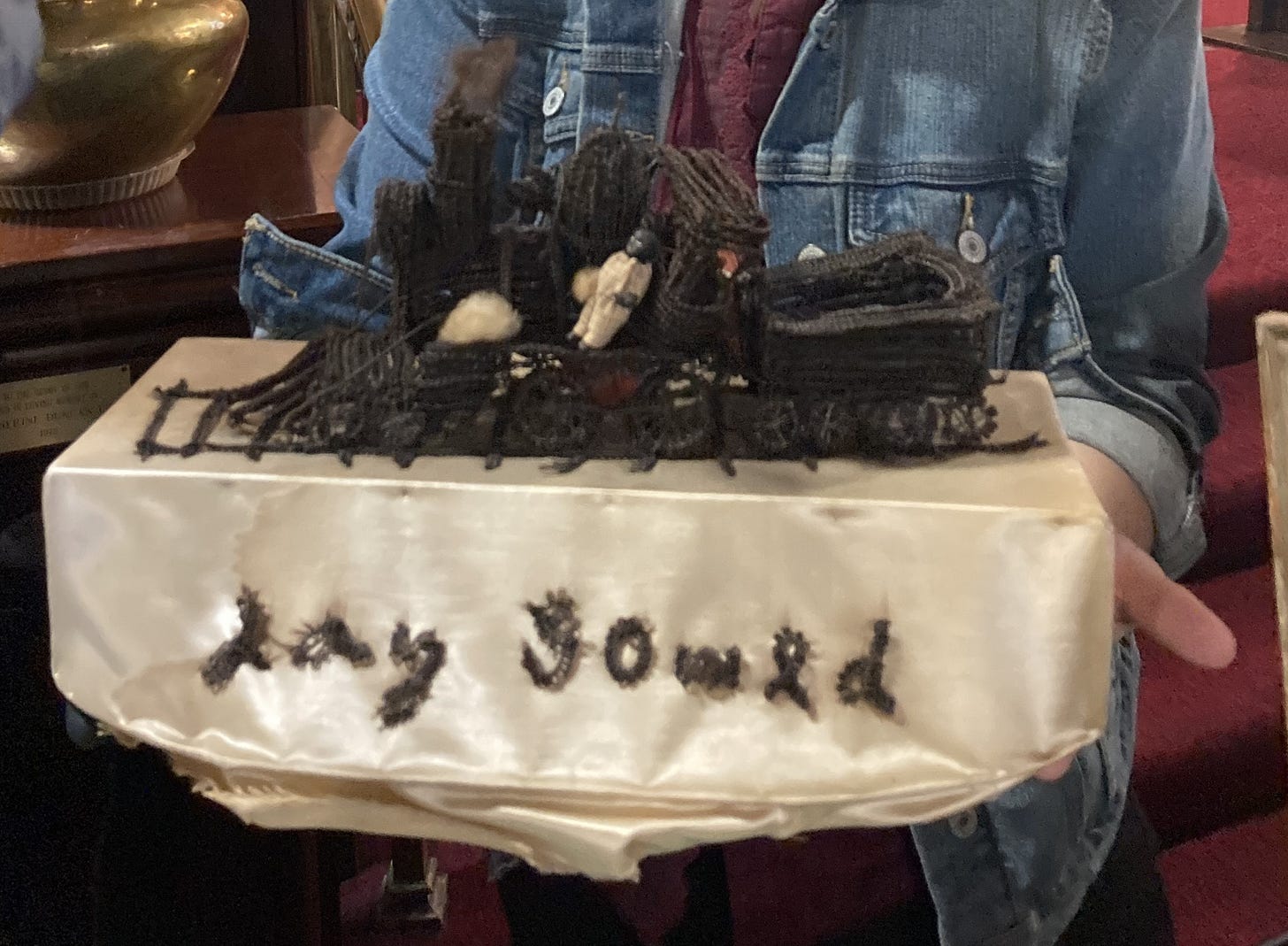
This perplexing hair train had been hidden among the giant collection of 10,000 objects accrued from the three family legacies (Paulding, Merritt, Gould) of Lyndhurst Mansion until Collections Coordinator Emma Gencarelli came upon a water-damaged box tucked away in a cupboard one day. Inside was this delicate locomotive fashioned from wire and elaborately woven with dark human hair. The piece perches on a cloth stitched with “Jay Gould,” the house’s last reigning rich patriarch, who along with all his success had a somewhat ghoulish reputation as railroad developer, financier, speculator, unscrupulous robber baron, and what one newspaper once called, “the most sinister figure ever to have flitted bat-like across the vision of the American people.”
Gently hovering over the train, there’s a tender curl of hair shooting up the chimney to represent smoke. And inside, a little doll perhaps meant to be the conductor. The story behind this is a mystery; both the gifter and the owner of the hair unknown. The hair is thought to be from a living person, so a sentimental gift in nature rather than any memorial to the dead. A possible DNA test is on the table. “We believe it was a gift to Jay Gould, because his name is on it. Possibly a c. 1875 date on it, but we don’t know,” Emma explains. “It’s not a mourning item, but some kind of personal memento.” Which was a pretty common thing I’m learning about lately now that the hair train has entered my consciousness: that fabricating art and jewelry from hair is a long-standing tradition, sometimes morbid and weird and sometimes just a normal part of everyday life.
“Hair is at once the most delicate and lasting of our materials and survives us like love. It is so light, so gentle, so escaping from the idea of death, that, with a lock of hair belonging to a child or friend, we may almost look to to Heaven and compare notes with angelic nature, may almost say: ‘I have a piece of thee here, not unworthy of thy being now.’
_Godley’s Lady’s Book, 1860
This mental hair ball I’ve been teasing apart gained mass when I got to visit the Tarrytown Gothic revival mansion lately for their Lyndhurst After Dark tours (which continue through month’s end if you’re interested). The tour of the estate was set up chronologically from the earliest inhabitants of the 1840s to the 1920s, and with the focus on funereal customs, the earlier seeds of our current Halloween, and the “dark art” proclivities of Gould who studied astrology, phrenology, palmistry, with his daughter later peering into a crystal ball when Spiritualism and communing with the dead was so trendy. Amidst the death anticipatory embroidery and the black crepe-draped portraits, I was thrilled to come upon a wreath woven from hair in the library. Emma filled me in, “the hair wreath was a living memorial of the Merritt family, likely constructed by the women in the family. Women’s handicraft in the nineteenth century included hair weaving and hairwork.”
This is a hairy rabbit hole that begs descending, so here I go. Photography wasn’t allowed during our mansion tour, so here’s an image of a very similar hair wreath care of The Children’s Museum of Indianapolis, with an explainer from Wisconsin’s Sauk County History site.
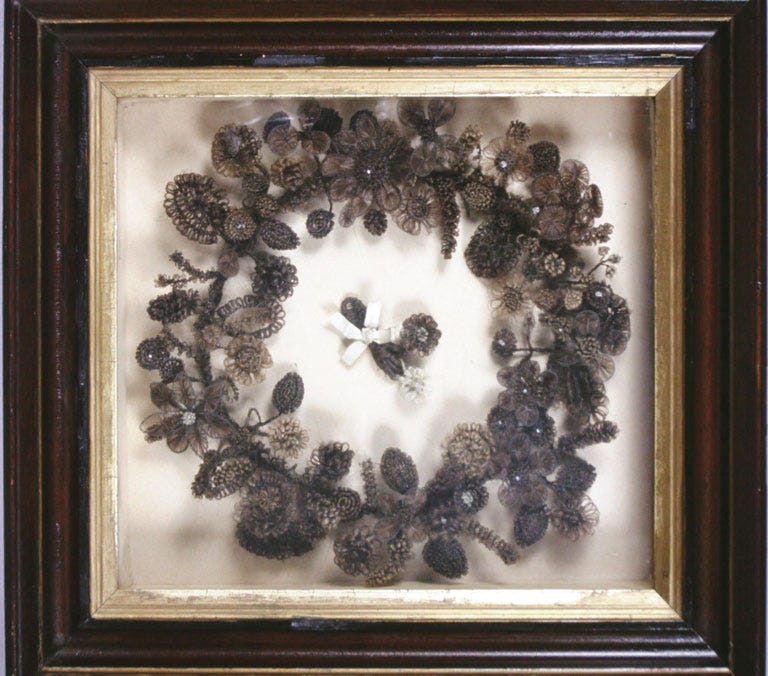
During the Victorian Era (1837-1901) European and North American women spent much of their day in the home. To pass the time, they indulged in “fancy work,” which they could display for their friends and neighbors and to decorate their otherwise mundane homes. One form of this fancy work consisted of making ornate creations from hair, similar to the older custom of placing a lock of hair of a loved one in a locket. Wreaths, lockets, bracelets, earrings and even toothpick holders would be fashioned out of hair. Women’s magazines depicted different patterns that could be used for these creations.
Back in the day, many women had long flowing hair, so there was a plentiful supply of raw material to work with. The tresses were woven around thin wire and formed into delicate designs of flowers, floral sprigs and leaves. Wooden or glass beads, buttons, and sometimes, seeds, were also included in the final product. Wreaths could be formed into horseshoe-shapes, a Victorian symbol of good luck, with the open end facing up to catch the luck. The resultant wreath was mounted on a silk or velvet background and placed in a fancy shadow box frame. Many of the wreaths extended to 18 inches or more in diameter.
The first rooms we toured in Lyndhurst were decorated according to the Victorian era in times predating photography. A young woman might actually depict herself in elaborate needle work next to a blank tomb in expectation of her future death. Death was just a normal part of life and to be celebrated within it, so much so that the parlor served as the funeral parlor where a body would lay in wait for days, until death eventually moved out of the house into actual funeral parlors. Only then could the parlor become the “living” room rather the dead one. Women in spaces like the adjacent library could busy themselves with this handiwork and not always with a theme so prone to their demise, but just pragmatically using the materials they had in abundance ever-growing from their own scalps.
According to the Sauk County site, “Hair receivers or keepers were fancy porcelain containers used to save the fallen or clipped locks of individuals and were usually identified as a jar with a hole in the cover to insert strands of hair.” You could learn this art guided by pattern books available, and there were even machine-made versions of hairwork that came from companies that produced en masse. Hair wreaths were originally made to honor the dead with a lock of the deceased featured in the center. If someone else died later, then a new lock would be placed at the center with the formerly deceased’s tendril moved to the outer ring. One’s hair might also end up in a broach to be worn for the year marked for mourning.
The Victorian trend for mourning hair art eventually moved into regular sentimental keepsakes for the living, with girls including locks of classmates in their scrapbooks. Valentines might include hair. Or autograph books with a little hair wreath from the signer. But this is an art that spans from regular to rarified, through the ages, and around the world:
Queen Victoria presented her children and grandchildren with jewelry made from her hair and Napoleon had a watch chain made from his wife’s hair.
The Art of Mourning site has a whole section on “hairwork” with some insanely elaborate weaves (and I’m not talking about the inane word salads that Trump serves up nor the assembled fluff spiral atop his head), with intricate hair-chains, cufflinks, shoe buckles (dating back to the 1600s), lockets, bracelets, crucifix.
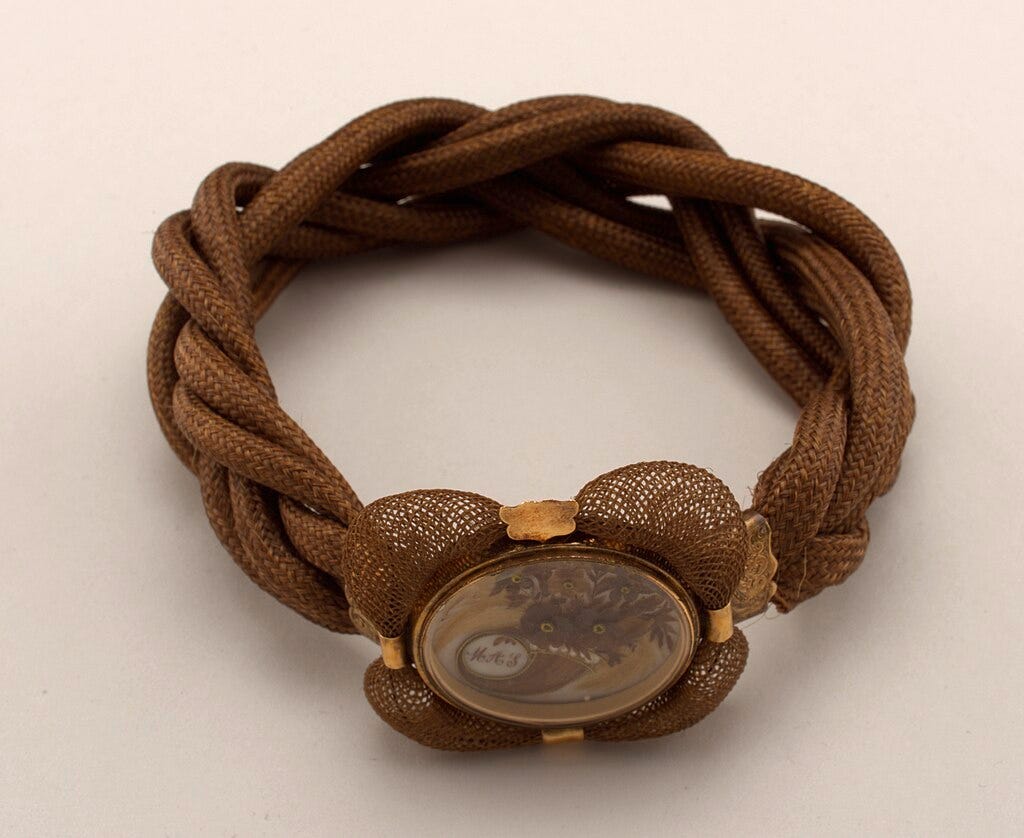
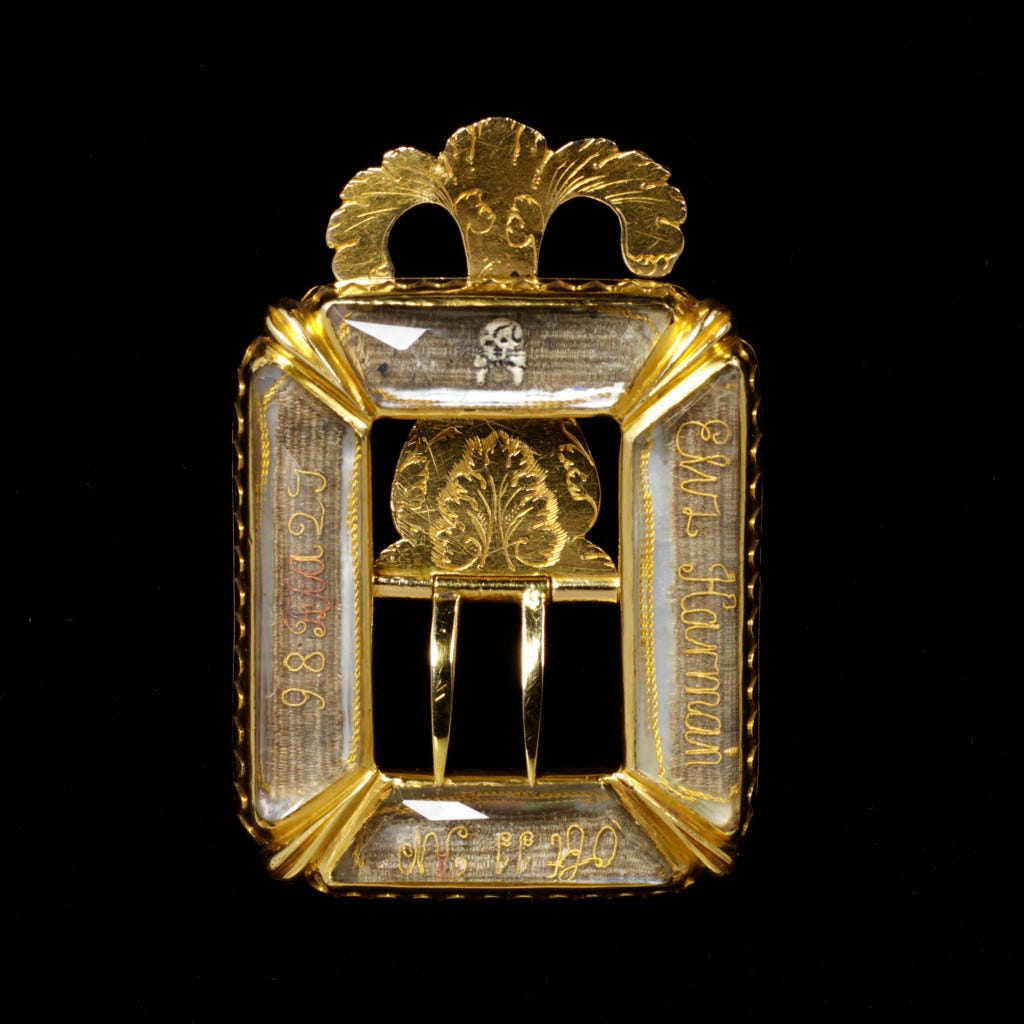
Throughout all of these examples, one can find the level of growth the industry saw in hairworking. Beginning as a way to display affection within a jewel, to a professional industry of skilled artists/weavers who could create entire works of art from hair in jewels, hair is singularly important in the growth of the memorial and sentimental jewelry industry. It is personal, malleable, beautiful and immediately arresting material that deserves its respect in history. In all of these examples, one can see the cost of the hairworked jewels and just how much hair was imported into England throughout the 19th century, proving that there is no material which could not be exploited for artistic merit, or human conceit so emotional that didn’t want a piece of the person they loved.
Today we might only save a lock from our baby’s first haircut. I admit I have this for my elder daughter whose haircut came only years into her bald then scantily-haired infancy and toddlerhood. And in my scrapbook my mom made for me, there is an envelope with my yellow original hair. As if spun from gold. They sit in my little cabinet of curiosities now in my bedroom, along with some tiny baby teeth and Dad’s ashes. Not enough to become wearable art, but we do live here in a tangly, teetering house of three females with long hair forever clogging drains and filling brushes, so we could potentially start collecting.


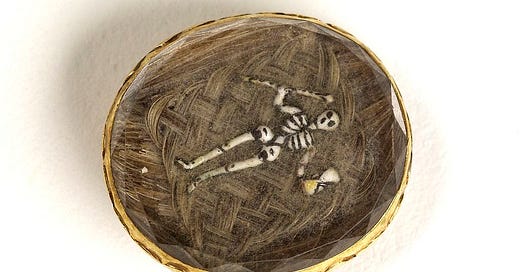



This is gross and creepy. Thank you for writing it 😂 I recently found a snip of my golden locks in my baby book. I did not snip my kids’ locks, but I kept their baby teeth, which is equally disgusting.
Hey yeah, I guess I kinda got a hair thing too (remember my novel)?
P.S. I kept some of my parrot's feathers I collected along the way. They're still holding their color. And you know feathers and hair are connected.